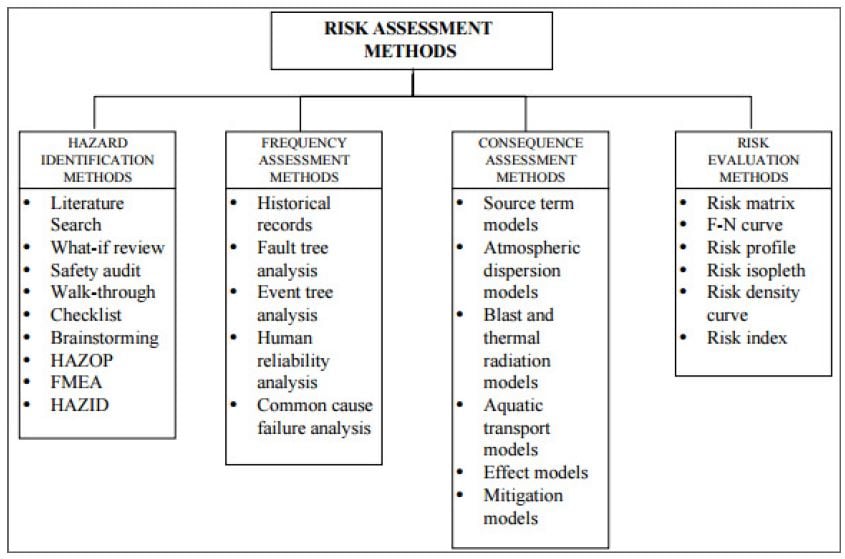
For both quantitative and qualitative approaches, a wide range of techniques exist as illustrated in the chart below (please refer the American Bureau of Shipping (2000) for more details). Each technique has its own:
- characteristics
- advantages
- disadvantages
- the fields of application.
These will be addressed in the later part of the section, as well as the next section.
Summary of primary risk assessment methods used in marine and offshore oil and gas industries for OHSE management (USA), 2000

Note: HAZID standards for hazard identification; HAZOP is hazard and operability; FMEA is failure mode and effect analysis. F-N cure is frequency-number of fatalities curve Source: American Bureau of Shipping (2000)
Qualitative or semi-quantitative techniques, such as:
- hazard matrices
- risk graphs
- risk matrices
- monographs
are often used for risk screening.
This is in contrast to complex risks that are assessed through more expensive and sophisticated quantitative techniques, such as actuarial and hybrid risk assessment models (Berg, 2010).
Special approaches are also available for analysing major risk in complex projects (Cagno, E., Caron, F., Mancini, M. 2007. A multidimensional analysis of major risks in complex projects. Risk Management: 1–18.).
How to choose the techniques you’ll need
The specific techniques used to identify and analyse risks, such as hazard and operational risks, depend on a range of relevant factors, particularly the:
- nature (including business model)
- size
- complexity, and
- the risk profile of the enterprise (The Canadian OFSI, 2016).
In a later blog, we will illustrate this topic with examples of risk assessment approaches and techniques used in different industries in the next section. In finance, business and operational research, there is considerable work related to risk matrices, covering both moment-based and quantile-based matrices. The moment-based matrices include, for example, expected loss functions and expected square loss, while quantile-based matrices include Value-at-Risk (VaR), and Conditional Value-at-Risk (CVaR) methods.
For risks characterised by high degree of uncertainties, such as climate change and emerging diseases, there seems to be broad acceptance of the need for looking beyond probability to robust and resilient approaches and methods that provide genuine breakthroughs for improving predictions and decisions. The combination of probability and qualitative approaches, and dynamic risk assessment and management are current and future research focuses (Aven, T 2016).
Traditional risk assessments are based on causal chains and event analysis, failure reporting and risk assessments, which calculate historical data-based probabilities. The traditional approach is not suitable for analysing complex systems, as it treats the system as comprising components with linear interactions, using methods, such as fault trees and event trees, and historical failure data. These problems are addressed in resilience engineering, which argues for more appropriate models and methods for such systems (see examples in Hollnagel, et al. (2006)). Alternative methods have been developed, of which FRAM and STAMP are among the most well-known (Hollnagel, 2004; Leveson, 2004, 2011). A variety of other risk assessment techniques have emerged, ranging from pure actuarial and hybrid models, to measurement methods that rely on risk self-assessment and expert opinion, to methods that use scenario-generated loss data, according to Towers Perrin (2008).
In our following blog, we will review a selection of primary methodologies and techniques used in the identification, analysis and evaluation stages of the risk assessment process by various industries, some of which are listed in the risk assessment methods in the chart in the USA oil and gas industry shown above. The analysis and evaluation techniques focus on those covering the combination of frequency, severity, exposure, and vulnerability, among other comprehensive methods, instead of only focusing on one element of risk measurement.




